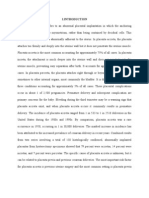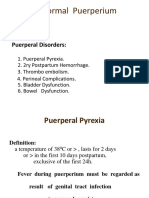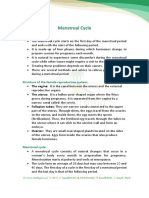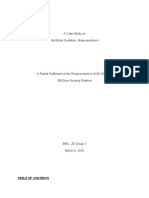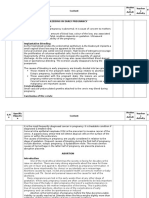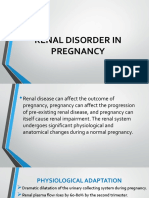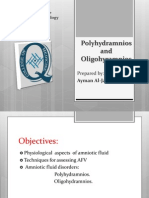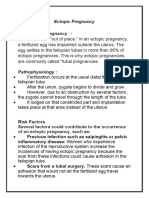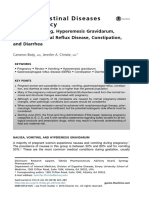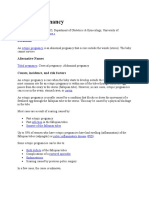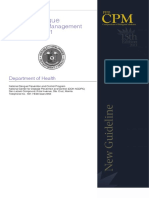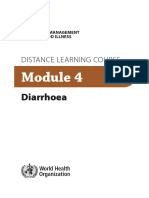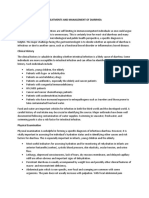Professional Documents
Culture Documents
Hyperemesis Gravidarum: By: Solomon Berhe OBGYN Resident
Uploaded by
muleget haile0 ratings0% found this document useful (0 votes)
1K views73 pagesHyperemesis gravidarum is a condition characterized by persistent and excessive vomiting during pregnancy. It is diagnosed when a pregnant woman experiences weight loss of over 5% of her pre-pregnancy weight along with ketonuria unrelated to other causes. Symptoms typically begin around 5-6 weeks of gestation and peak at 9 weeks, usually resolving by 16-20 weeks. Laboratory tests may show dehydration, electrolyte imbalances, and elevated liver enzymes. The exact causes are unknown but are likely multifactorial involving genetic, hormonal, gastrointestinal, and psychological factors.
Original Description:
Original Title
HYPEREMESIS GRAVIDARUM.pptx
Copyright
© © All Rights Reserved
Available Formats
PPTX, PDF, TXT or read online from Scribd
Share this document
Did you find this document useful?
Is this content inappropriate?
Report this DocumentHyperemesis gravidarum is a condition characterized by persistent and excessive vomiting during pregnancy. It is diagnosed when a pregnant woman experiences weight loss of over 5% of her pre-pregnancy weight along with ketonuria unrelated to other causes. Symptoms typically begin around 5-6 weeks of gestation and peak at 9 weeks, usually resolving by 16-20 weeks. Laboratory tests may show dehydration, electrolyte imbalances, and elevated liver enzymes. The exact causes are unknown but are likely multifactorial involving genetic, hormonal, gastrointestinal, and psychological factors.
Copyright:
© All Rights Reserved
Available Formats
Download as PPTX, PDF, TXT or read online from Scribd
0 ratings0% found this document useful (0 votes)
1K views73 pagesHyperemesis Gravidarum: By: Solomon Berhe OBGYN Resident
Uploaded by
muleget haileHyperemesis gravidarum is a condition characterized by persistent and excessive vomiting during pregnancy. It is diagnosed when a pregnant woman experiences weight loss of over 5% of her pre-pregnancy weight along with ketonuria unrelated to other causes. Symptoms typically begin around 5-6 weeks of gestation and peak at 9 weeks, usually resolving by 16-20 weeks. Laboratory tests may show dehydration, electrolyte imbalances, and elevated liver enzymes. The exact causes are unknown but are likely multifactorial involving genetic, hormonal, gastrointestinal, and psychological factors.
Copyright:
© All Rights Reserved
Available Formats
Download as PPTX, PDF, TXT or read online from Scribd
You are on page 1of 73
HYPEREMESIS GRAVIDARUM
By: Solomon Berhe
OBGYN resident
Definition
Common criteria for diagnosis of hyperemesis are
persistent vomiting accompanied by weight loss
exceeding 5 percent of prepregnancy body
weight and ketonuria unrelated to other causes.
Alternatively, the diagnosis can be made in
women with pregnancy-related vomiting that
occurs greater than three times per day with
weight loss greater than 3 kg or 5 percent of body
weight and ketonuria .
Cont…
The mean onset of symptoms is at 5 to 6 weeks
of gestation, peaking at about 9 weeks, and
usually abating by 16 to 20 weeks of gestation;
however, symptoms may continue until the third
trimester in 15 to 20 percent of gravida and until
delivery in 5 percent.
Sixty percent of women are asymptomatic six
weeks after onset of nausea.
If vomiting persists beyond a few days
postpartum , other etiologies should be
investigated.
Cont…
Maternal factors shown to increase the rate of
hospitalization due to hyperemesis
gravidarum include:
Hyperthyroidism
Psychiatric disorders
Diabetes
Gastrointestinal disorders and
Asthma
Cont…
About 10% of patients are affected
throughout pregnancy.
This disorder leads to elective pregnancy
termination in approximately 2% of affected
pregnancies.
Cont…
In contrast to women with mild disease,
women with hyperemesis have
orthostatic hypotension,
laboratory abnormalities, and
physical signs of dehydration, and often
require hospitalization for stabilization.
In addition, many women with hyperemesis
hypersalivate (ptyalism)
INCIDENCE
Some degree of nausea with or without
vomiting occurs in 50 to 90 percent of all
pregnancies.
The incidence of women with severe
symptoms is not well-documented; reports
vary from 0.3 to 2 percent of pregnancies.
Ethnic differences and differences in the
definition of the disease may account, in part,
for the variability.
Cont…
more common in Western nations and urban
areas than in Africa and Asia.
Younger primigravid women are more likely to
be affected than older multiparous women,
but data have not been consistent.
Incidence Cont…
– There has been marked fall in the incidence during
the last 30yrs.the reasons are:
Better application of family planning knowledge
which reduces the number of unplanned
pregnancies.
Early visit to the antenatal clinic and
Potent antihistaminic, antiemetic drugs.
Risk factors
Nonpregnant women who experience nausea and
vomiting related to estrogen–based medication,
motion, or migraine.
Women who are supertasters are also at increased risk;
in contrast, anosmic women appear to be at low risk
women with multiple gestations,
women with hydatidiform mole
women who did not take multivitamins either prior to
6 weeks of gestation or during the peri-conceptional
period and women with heartburn and acid reflux
Cont…
genetic factors appear to play a role. A population-
based cohort study found that daughters of women
with hyperemesis were at significantly higher risk of
developing hyperemesis in their own pregnancy
compared to daughters of women without
hyperemesis (3 versus 1 percent), while female
partners of sons of women with hyperemesis were not
at increased risk .
Other studies have reported a significantly higher risk
of hyperemesis gravidarum in women whose sister or
mother experienced the disorder, in monozygotic twins
compared with dizygotic twins, and in women with
certain genetically determined conditions.
Cont….
Interestingly, studies consistently report a
preponderance of female fetuses among
pregnancies complicated by hyperemesis
(odds of female fetus 1.27, 95% CI 1.21-1.34).
Alcohol use and cigarette smoking (perhaps
due to the effect of nicotine) appear to be
protective factors
Cont…
Scoring systems — The Motherisk-PUQE scoring index and the
Rhodes Index are tools for quantifying the severity of nausea and
vomiting in pregnancy and following the course of the condition;
they have been used predominantly in research studies .
These indices use a point system to assign points for the number of
hours each day the woman feels nauseated, the number of times
she vomits, and the number of times she has dry heaves. A high
score indicates the woman should be evaluated for dehydration and
her serum electrolyte levels should be checked.
Some clinicians find that these tools are helpful in assessing
symptoms in their patients, but they have not been validated for
guiding management of nausea and vomiting of pregnancy in the
clinical setting.
PATHOGENESIS
The predominant theories are described below:
Psychologic factors:
(1) a conversion or somatization disorder or
(2) a response to stress
A feeling of ambivalence about the pregnancy has
been proposed as an etiologic or contributing
factor.
The woman’s psychological response to persistent
nausea and vomiting may exacerbate her
symptoms as a result of conditioning.
Cont…
Hormonal changes :
No single hormonal profile can accurately predict
the presence of hyperemesis gravidarum.
Elevated serum concentrations of estrogen and
progesterone have long been implicated in the
pathogenesis of this disorder.
These hormones relax smooth muscle and thus
slow gastrointestinal transit time and may alter
gastric emptying.
Cont…
serum concentrations of human chorionic
gonadotropin (hCG) peak during the first
trimester, the time when hyperemesis
gravidarum is typically seen.
A causal association between hCG levels and
hyperemesis gravidarum has not been firmly
established.
Cont…
Abnormal gastrointestinal motility:
Gastric motility may be abnormal (delayed or
dysrhythmic) in women with hyperemesis
gravidarum.
Helicobacter pylori — Most women with H.
pylori do not develop severe nausea and
vomiting in pregnancy, but the infection may
play a role in pathogenesis of disease in some
women.
Pathogenesis cont…
Vomiting — Vomiting is a reflex that allows an animal
to rid itself of ingested toxins or poisons. It can be
activated by humoral or neuronal stimuli, or both.
Multiple afferent and efferent pathways exist which
induce vomiting;
the following are the major components of these
pathways:
The area postrema in the floor of the fourth ventricle
which contains a "chemoreceptor trigger zone" that is
sensitive to many humoral factors, including
neurotransmitters, peptides, drugs, and toxins.
Cont…
Vagal afferent nerves from the gastrointestinal
tract synapse in the NTS. From there, some
neurons extend to the area postrema; other
neurons from the NTS ascend to the
paraventricular nuclei of the hypothalamus
and the limbic and cortical regions, where
gastric electromechanical events are
perceived as normal sensations or symptoms
such as nausea or discomfort.
Cont…
An area in the medulla known as the nucleus
tractus solitarius (NTS) which may serve as a
central pattern generator for vomiting;
information from humoral factors via the area
postrema and visceral afferents via the vagus
nerve may converge at this site.
The central pattern generator presumably
projects to the various motor nuclei to elicit the
sequential excitation and inhibition that controls
the vomiting reflex.
Diagnosis
Clinical symptoms include:
Dry mouth
Sialorrhea
Hyperolfaction and
Altered taste.
Physical Examination:
Tachycardia, hypotension
Dry mucous membranes
Poor skin turgor
INVESTIGATION
• The standard initial evaluation of pregnant women
with persistent nausea and vomiting includes
measurement of:
Weight
Orthostatic blood pressures
Heart rate
serum electrolytes, and urine ketones and specific
gravity
An obstetrical ultrasound examination is performed to
look for gestational trophoblastic disease and multiple
gestation,
Cont…
Based on patient-specific factors, such as severity of
disease and associated symptoms, one or more of the
following additional blood tests can be ordered to
assess the woman’s volume/metabolic status or to
exclude other diagnoses:
Blood urea nitrogen, creatinine
complete blood count
liver function tests,
thyroid function tests
Amylase/lipase, and calcium level.
lab
Findings — Laboratory abnormalities that can be caused by
nausea and vomiting of pregnancy include:
Electrolyte and acid-base derangements, such as
hypokalemia and hypochloremic metabolic alkalosis, from
vomiting gastric secretions. Ketosis can occur if caloric intake
is minimal.
An increase in hematocrit, indicating hemoconcentration due
to plasma volume depletion. The degree of
hemoconcentration may be underestimated unless the
physiologic decline in hematocrit seen in normal pregnancies
is considered.
Other signs of dehydration include an elevated blood urea
nitrogen and urine specific gravity.
Cont…
Abnormal liver enzyme values occur in
approximately 50 percent of patients who are
hospitalized with hyperemesis. The most striking
abnormality is an increase in serum
aminotransferases. Alanine aminotransferase (ALT) is
typically elevated to a greater degree than aspartate
aminotransferase (AST). Values for both are typically
only mildly elevated, eg, in the low hundreds or two
to three times the upper limit of normal, and rarely
as high as 1000 U/L. Hyperbilirubinemia also can
occur, but rarely exceeds 4 mg/dL .
Cont…
The degree of abnormality in liver tests correlates
with severity of vomiting; the highest elevations
are seen in patients with the most severe or
protracted vomiting. Abnormal liver biochemical
tests resolve promptly upon resolution of
vomiting.
When a liver biopsy has been performed, it was
either normal or showed nonspecific findings.
Inflammation was absent, but necrosis with cell
drop out, steatosis centrilobular vacuolization,
and rare bile plugs have been seen . These
changes help to explain the mechanism for the
Cont…
Serum amylase and lipase may increase as
much as 5-fold (as opposed to a 5- to 10-fold
increase in acute pancreatitis) and are of
salivary rather than pancreatic origin
Mild hyperthyroidism, possibly due to high
serum concentrations of human chorionic
gonadotropin which has thyroid-stimulating
activity. One report noted low serum TSH
concentrations more often in women with
hyperemesis gravidarum than in normal
Cont…
Features that distinguish the transient hyperthyroidism
of hyperemesis gravidarum from hyperthyroidism of
other causes (which in a pregnant woman is most likely
due to Graves' disease) are:
the vomiting
absence of goiter and ophthalmopathy, and
absence of the common symptoms and signs of
hyperthyroidism (heat intolerance, muscle weakness,
tremor). In addition, serum free T4 concentrations are
only minimally elevated and serum T3 concentrations
are not elevated in women with hyperemesis
gravidarum, whereas both are usually unequivocally
elevated in pregnant women with true
DIFFERENTIAL DIAGNOSIS
Nausea and vomiting that develop after 10
weeks of gestation are not likely due to this
disorder.
The presence of associated signs and
symptoms, such as bilious emesis, abdominal
pain, fever, headache, abnormal neurologic
findings, diarrhea, constipation, leukocytosis,
goiter, or hypertension, also suggests another
diagnosis is likely.
Differential diagnosis Cont…
UTI, (Pyelonephritis)
Uncontrolled diabetes
Hepatitis
Pancreatitis
MANAGEMENT
GOAL OF TREATMENT — The treatment goals
in patients with nausea and vomiting of
pregnancy are to:
Reduce symptoms through changes in
diet/environment and by medication
Correct consequences or complications of
nausea and vomiting (eg, fluid depletion,
hypokalemia, and metabolic alkalosis)
Minimize the fetal effects of maternal nausea
and vomiting and their treatment
Management Cont….
INITIAL APPROACH — Generally, treatment
begins with advice about diet, avoidance of
triggers, and non-pharmacologic interventions,
such as acupressure; oral or rectal medications
are added if symptoms do not improve.
Diet — Meals and snacks should be eaten slowly
and in small amounts every one to two hours to
avoid a full stomach.
Women with nausea should eat before, or as
soon as, they feel hungry to avoid an empty
stomach, which can aggravate nausea.
Management Cont….
frequent small carbohydrate meals, such as
soda crackers or dry toast, based primarily on
historical anecdotal reports.
Although scientific data on the effect of
dietary components on nausea are sparse,
there is some evidence that protein-
predominant meals/snacks produce
quantifiable decreases in nausea.
Management Cont….
Woman should figure out what foods they
tolerate best and try to eat those foods.
Dietary manipulations that help some women
include eliminating coffee and spicy, odorous,
high fat, acidic, and very sweet foods, and
substituting snacks/meals that are protein
dominant, salty, low fat, bland, and/or dry (eg,
nuts, pretzels, crackers, cereal, toast)
Fluids are better tolerated if cold, clear, and
carbonated or sour (eg, ginger ale, lemonade,
Management Cont….
Aromatic therapies involving lemon
(lemonade), mint (tea), or orange have also
been described as useful.
Fluids should be consumed at least 30
minutes before or after solid food to minimize
the effect of a full stomach.
Patients whose symptoms are related to
delayed gastric emptying should improve with
a diet comprised of liquids and low fat solids
since these foods are more readily emptied by
Nonpharmacologic interventions
Avoidance of triggers:
The cornerstone of nonpharmacologic therapy of
hyperemesis gravidarum is avoidance of
environmental triggers .
Examples of some triggers include: stuffy rooms,
odors (eg, perfume, chemicals, food, smoke),
heat, humidity, noise, and visual or physical
motion (eg, flickering lights, driving).
Quickly changing position and not getting enough
rest, particularly after eating, may also aggravate
symptoms.
Nonpharmacologic interventions
Cont…
Cold solid foods are tolerated better than hot
solid foods because they have less odor and
require less preparation time (ie, shorter
exposure to the trigger if the woman is
preparing her own meal).
Brushing teeth after a meal, spitting out saliva,
and frequently washing out the mouth can be
helpful.
Nonpharmacologic interventions
Cont…
Acupuncture and acupressure-P6 acupressure
wristbands
Pressure or massage at the P6 acupressure
point is reported in some studies to relieve
motion sickness.
The point is found three of the patient's
fingerbreadths proximal to the proximal wrist
fold, between the palmaris longus and flexor
carpi radialis tendons, shown in this picture by
the tip of the pen.
Nonpharmacologic interventions
Cont…
Nonpharmacologic interventions
Cont…
Hypnosis — Hypnosis has been reported to
be helpful in some patients.
Psychotherapy can also be a useful adjunctive
therapy, particularly if psychological sources of
anxiety are identified and can be ameliorated.
Pharmacologic treatment
Ginger — Randomized trials and controlled
studies suggest that powdered ginger (1 to 1.5
grams in divided doses over 24 hours) is more
effective than placebo, and equivalent to
vitamin B6 (pyridoxine) for treatment of
nausea and vomiting of pregnancy.
larger studies are needed to establish the
safety and efficacy of ginger.
Pharmacologic treatment Cont…
Pyridoxine (vitamin B6) — Pyridoxine is a
water-soluble B-complex vitamin that is a
necessary coenzyme in the metabolism of
lipids, carbohydrates, and amino acids.
It can be used as a single agent or in
conjunction with doxylamine succinate for the
treatment of nausea of pregnancy.
As a single agent, the initial dose of pyridoxine
is 25 mg orally every six to eight hours; the
maximum dose suggested for pregnant
Pharmacologic treatment Cont…
it is a reasonable first-line treatment for
nausea and vomiting of pregnancy, either
alone or in combination with doxylamine
succinate.
Pharmacologic treatment Cont…
Antihistamines (H1 antagonists
The most commonly used antihistamine is
doxylamine in combination with pyridoxine.
Other antihistamines that have been used
independently to treat nausea and vomiting of
pregnancy include meclizine , dimenhydrinate
, and diphenhydramine .
Pharmacologic treatment Cont…
The primary mechanism of antihistamines in
treatment of nausea and vomiting of
pregnancy is:
direct inhibition of histamine at the histamine
1 (H1) receptor.
the secondary mechanism is an indirect effect
on the vestibular system by decreasing
stimulation of the vomiting center.
In addition, these agents inhibit the
muscarinic receptor, which may mediate the
Pharmacologic treatment Cont…
Doxylamine succinate and pyridoxine is an
antihistamine that is usually taken with
pyridoxine.
The combination appears to improve efficacy and
was the formulation for Bendectin.
Bendectin was voluntarily withdrawn from the
market in 1983 due to lawsuits alleging
teratogenicity, although scientific evidence
supports its safety.
Initially, two delayed release tablets of Diclectin
(a total of doxylamine 20 mg and pyridoxine 20
Pharmacologic treatment Cont…
SECONDARY APPROACH
Women without dehydration:
First-line therapy:
Antihistamines (H1 antagonists):
Diphenhydramine — Diphenhydramine 25 to
50 mg can be taken orally every four to six
hours, as needed.
It can also be given intravenously 10 to 50 mg
every four to six hours, as needed.
Pharmacologic treatment Cont…
Meclizine — Meclizine 25 mg can be taken
orally every four to six hours, as needed.
Meclizine has caused cleft palate in rats.
Three large studies did not show an increased
risk of malformations.
Pharmacologic treatment Cont…
Dimenhydrinate — When oral medications
are tolerated, dimenhydrinate 25 to 50 mg can
be taken orally every four to six hours, as
needed.
Otherwise, 50 mg dimenhydrinate is
administered intravenously over 20 minutes
or 50 to 100 mg is administered rectally
(where available) every four to six hours, as
needed; the total dose should not exceed 400
mg/day.
Pharmacologic treatment Cont…
Second-line therapy
Dopamine antagonists
During nausea and vomiting, dopamine
receptors in the stomach mediate the
inhibition of gastric motility and, therefore,
may provide a site of action for antiemetic
dopamine receptor antagonists.
Dopamine, specifically at the dopamine 2
receptors, is also implicated in emetic
signaling through the chemoreceptor trigger
Pharmacologic treatment Cont…
• The three main classes of dopamine receptor
antagonists are
phenothiazines ( promethazine and
prochlorperazine)
butyrophenones ( droperidol ), and
benzamides ( metoclopramide ).
Pharmacologic treatment Cont…
Prochlorperazine and chlorpromazine:
Prochlorperazine 5 to 10 mg orally,
intravenously, or intramuscularly every six
hours or 25 mg per rectum twice per day, as
needed, appears to benefit some patients.
Pharmacologic treatment Cont…
Metoclopramide — Metoclopramide 10 mg
orally, intravenously, or intramuscularly
(ideally 30 minutes prior to meal and at
bedtime) every six to 8 hours is commonly
prescribed for nausea and vomiting related to
pregnancy.
In the only randomized trial evaluating this
drug in women with hyperemesis,
metoclopramide 10 mg was as effective as
promethazine 25 mg.
Maternal side effects are a concern, especially
Pharmacologic treatment Cont…
Disadvantages include prominent sedation
and risk of dystonic reactions.
Pharmacologic treatment Cont…
Serotonin antagonists — Ondansetron ,
granisetron , and dolasetron are selective
antagonists at the 5-HT3 serotonin receptor.
Ondansetron — Ondansetron 4 to 8 mg can
be taken orally every eight hours, as needed,
or administered intravenously by bolus
injection every eight hours, as needed.
Headache, fatigue, constipation, and
drowsiness are the most common side effects.
Ondansetron can cause QT prolongation,
particularly in patients with underlying heart
Pharmacologic treatment Cont…
Adjunctive therapy
Acid reducing agents — Acid reducing
medications can be used as adjunctive
therapy.
In women with heartburn/acid reflux and
nausea/vomiting of pregnancy, an
observational study found that acid-reducing
pharmacotherapy (eg, antacids, H2 blockers,
proton pump inhibitors) combined with anti-
emetic therapy resulted in significant
Pharmacologic treatment Cont…
Antacids containing aluminum or calcium are
safe and preferable to those containing
bismuth or bicarbonate, which may have
adverse fetal/neonatal effects.
The greatest experience with pharmacologic
acid-suppressive therapy in pregnant women
has been with the H2 receptor antagonists
ranitidine and cimetidine , which appear to
be safe during pregnancy.
Pharmacologic treatment Cont…
Women with any of the following conditions need
to be admitted for in patient management.
severe vomiting
weight loss
Ketonuria
dry mucous membranes
poor skin turgor
dehydration, hypotension
alkalosis from hydrochloric acid loss,
Pharmacologic treatment Cont…
In women with persistent vomiting after
hospitalization, it is important to exclude
underlying diseases that can cause
hyperemesis.
These patients and their families often need
emotional support to help deal with stress
and anxiety about the maternal illness and its
effect on the fetus, and the disruption to their
home- and work-related activities.
In some cases, psychiatric consultation can be
Fluids and nutrition
Many patients respond to intravenous
hydration and a short period of gut rest,
followed by reintroduction of oral intake and
pharmacologic therapy.
Fluids: 2 L intravenous Ringer’s lactate infused
over three to five hours, supplemented with
appropriate electrolytes and vitamins.
Subsequently, the infusion rate is adjusted to
maintain a urine output of at least 100
mL/hour and the solution is changed to
dextrose 5% in 0.45% saline.
Fluids and nutrition Cont…
dextrose infusion should be delayed until after
the patient has received thiamine in her initial
rehydration fluid, at least it should be given
equally, but not before thiamine
supplementation.
Vitamins and minerals: If the patient is
experiencing persistent vomiting, it is important
to replenish low levels of vitamins (especially
thiamine), electrolytes, and minerals (ie,
magnesium, calcium, and phosphorous).
each day administer a multivitamin (MVI)
Fluids and nutrition Cont…
• Diet — A diet that attempts to minimize
nausea and vomiting can be resumed after a
short period of gut rest. We usually begin
women on a diet consisting of bananas, rice,
applesauce, and toast (BRAT diet) and then
advance their diet as tolerated. Consistent
protein intake is key in helping prevent
nausea.
Chlorpromazine — We have found
REFRACTORY PATIENTS
chlorpromazine (25 to 50 mg intravenously or
intramuscularly or 10 to 25 mg orally every
four to six hours) to be helpful in refractory
cases.
A rectal suppository may be available in some
countries.
Adverse effects include extrapyramidal
reactions, orthostatic hypotension,
anticholinergic effects, and altered cardiac
Glucocorticoids
Glucocorticoids have been used in women
with severe and refractory hyperemesis,
although the mechanism of action is not well
understood.
Glucocorticoid use has been associated with a
slightly increased risk of oral clefts when the
drug is administered before 10 weeks of
gestation; therefore, ideally, use of
glucocorticoids should be avoided in the first
trimester.
Glucocorticoids Cont…
An effective dose is methylprednisolone (16 mg)
intravenously every 8 hours for 48 to 72 hours.
Methylprednisolone can be stopped abruptly if
there is no response, and tapered over two
weeks in women who experience relief of
symptoms.
After intravenous therapy, we can use an oral
prednisone taper regimen of:
40 mg oral prednisone per day for one day,
followed by
20 mg per day for three days, followed by
Enteral and parenteral nutrition
Women who are refractory to all pharmacologic
and nonpharmacologic interventions should be
supported with enteral (tube feedings) or
parenteral nutrition and intravenous fluids as
long as necessary.
In general, enteral nutrition is begun in women
who cannot maintain their weight because of
vomiting and despite a trial of the interventions.
Enteral nutrition via gastric or duodenal
intubation is preferable to the parenteral route
and may relieve the nausea and vomiting.
Increased risk of complication, infusion catheter
MANAGEMENT OF STABLE AND
IMPROVING PATIENTS
Continue the drug regimen that has been
effective until the patient has been completely
asymptomatic (no nausea or vomiting) for at
least a week.
At that time, discontinue the medications and
see how she does.
If nausea and vomiting recurs, we resume
therapy.
OUTCOME AND PROGNOSIS
women with severe vomiting who require
multiple hospitalizations may not have "catch
up" weight gain; an adverse effect on
birthweight is more likely in these women .
Women who have less than 7 kg weight gain
are more likely to have a preterm birth/low
birth weight infant, small for gestational age
neonate and 5- minute a Apgar scores less
than 7.
There are no good data on long-term maternal
Recurrence
Two population based series reported the risk
of recurrent hyperemesis in a second
pregnancy was 15 and 20 percent in women
with previous hyperemesis, but only 0.7
percent in women with no such history.
PREVENTION
Ideally, all women of child-bearing age should
be advised to take a daily multivitamin with
folic acid beginning in the preconception
period; this reduces the risk of congenital
anomalies, particularly neural tube defects,
and may help to decrease the frequency and
severity of nausea and vomiting during
pregnancy.
The positive effects of multivitamins are likely
due to the general optimization of nutritional
PREVENTION
In addition, heartburn and acid reflux have
been associated with increased severity of
nausea and vomiting of pregnancy, which
suggests that managing these disorders prior
to pregnancy might prevent or reduce the
severity of symptoms.
Complication
Electrolyte imbalance
Nutritional deficiencies
Wernicke encephalopathy
Pneumomediastinum
Esophagial rupture
Esophageal tears (Mallory-Weiss)
osmotic demyelination syndrome (formerly
known as central pontine myelinolysis)
hepatic insufficiency, and
acute tubular necrosis
Reference
• Up to date 21.2
• Williams obstetric 24th ed.
• Creasy& Resnik’s Maternal- Fetal Medicine
• D.C. Dutta’s Text book of obstetrics
You might also like
- Hyperemesis Gravidarum PresentationDocument22 pagesHyperemesis Gravidarum PresentationMaricar Sanson FelicianoNo ratings yet
- Incompetent CervixDocument29 pagesIncompetent CervixCyrelle Jen TorresNo ratings yet
- Case Study AccretaDocument35 pagesCase Study AccretaM Clarisse ParicoNo ratings yet
- PIHDocument4 pagesPIHCatherine PradoNo ratings yet
- Abnormal PuerperiumDocument21 pagesAbnormal PuerperiumNatukunda DianahNo ratings yet
- Menstrual CycleDocument9 pagesMenstrual Cyclevarshasharma05100% (2)
- Multifetal Gestation Case StudyDocument67 pagesMultifetal Gestation Case StudyNikki Joy NavarroNo ratings yet
- Nordayana Yunus - Feto Pelvic Relationship-1Document5 pagesNordayana Yunus - Feto Pelvic Relationship-1Nana Yunus100% (1)
- Asphyxia NeonatorumDocument34 pagesAsphyxia NeonatorumListya Paramita100% (1)
- Acog Nausea Vomiting PregnancyDocument13 pagesAcog Nausea Vomiting PregnancymispNo ratings yet
- Presentation On: Pueperal Sepsis: Submitted To: Sandhya Maam Submitted By: Dhana BC Kismita Rai BSC 3 YearDocument31 pagesPresentation On: Pueperal Sepsis: Submitted To: Sandhya Maam Submitted By: Dhana BC Kismita Rai BSC 3 YearRumi Maharjan100% (1)
- Hyperemesis GravidarumDocument12 pagesHyperemesis GravidarumSiska FriedmanNo ratings yet
- Incompetent CervixDocument4 pagesIncompetent CervixCharm Arroyo100% (1)
- Hydatidiform Mole/ Molar Pregnancy: College of Health SciencesDocument11 pagesHydatidiform Mole/ Molar Pregnancy: College of Health SciencesAngelu Gabrielle CastroNo ratings yet
- Hyperemesis GravidarumDocument14 pagesHyperemesis Gravidarumamelina0% (1)
- Pediatric Gastroenterology Algorithme PDFDocument118 pagesPediatric Gastroenterology Algorithme PDFJonathan Welch100% (1)
- Pediatric Fluid and Electrolyte AlterationsDocument51 pagesPediatric Fluid and Electrolyte AlterationsMatthew Ryan100% (1)
- Hyperemesis GravidarumDocument16 pagesHyperemesis GravidarumBabi PanggangNo ratings yet
- Hyperemesis GravidarumDocument5 pagesHyperemesis GravidarumGladys Ocampo100% (5)
- GDMDocument13 pagesGDMSharmistha DebnathNo ratings yet
- Bleeding in Early PregnancyDocument25 pagesBleeding in Early PregnancyAnnapurna DangetiNo ratings yet
- Case Analysis - Hyperemesis GravidarumDocument8 pagesCase Analysis - Hyperemesis GravidarumcchiechieNo ratings yet
- AbortionDocument121 pagesAbortionSindhu JojoNo ratings yet
- Placenta Previa Case StudyDocument7 pagesPlacenta Previa Case StudyKing NavsunNo ratings yet
- Genital Tract InjuriesDocument37 pagesGenital Tract InjuriesShady Abdelbari83% (6)
- Placenta PreviaDocument33 pagesPlacenta PreviaAcohCChao100% (1)
- Renal Disorder in PregnancyDocument34 pagesRenal Disorder in PregnancyOfel Santillan100% (2)
- Food PoisoningDocument11 pagesFood PoisoningLeanne Teh100% (1)
- Case Study For OligohydramniosDocument8 pagesCase Study For OligohydramniosKinjal Vasava100% (1)
- Case Study H MOLEDocument11 pagesCase Study H MOLEmaori_martinez82% (11)
- Polyhydramnios and OligohyramniosDocument35 pagesPolyhydramnios and Oligohyramniosaymanway50% (2)
- Breast Complications in PuerperiumDocument24 pagesBreast Complications in Puerperiumvincentsharon100% (9)
- Placenta Previa Case StudyDocument7 pagesPlacenta Previa Case StudyphearlieNo ratings yet
- Ectopic PregnancyDocument3 pagesEctopic PregnancyMary Anne Yap100% (1)
- Unit 7 - Vesicular MoleDocument43 pagesUnit 7 - Vesicular MoleN. Siva100% (1)
- September 16 - IMCIDocument5 pagesSeptember 16 - IMCIJonas Marvin AnaqueNo ratings yet
- Large For Gestational AgeDocument6 pagesLarge For Gestational AgeEries Lacanlale Lumba100% (1)
- PUERPERIUMDocument58 pagesPUERPERIUMPencenk Azznew100% (4)
- Hydatidiform MoleDocument23 pagesHydatidiform MoleKristel Rivamonte100% (1)
- Retained Placenta After Vaginal Birth and Length of The Third Stage of Labor - UpToDateDocument19 pagesRetained Placenta After Vaginal Birth and Length of The Third Stage of Labor - UpToDateHartanto Lie100% (1)
- Biochemical Aspect of DiarrheaDocument17 pagesBiochemical Aspect of DiarrheaLiz Espinosa0% (1)
- Ectopic PregnancyDocument10 pagesEctopic PregnancyXo Yem0% (1)
- Early Pregnancy Bleeding: 1. Abortion 2. Ectopic Pregnancy 3. GTDDocument48 pagesEarly Pregnancy Bleeding: 1. Abortion 2. Ectopic Pregnancy 3. GTDGebremichael Reta100% (2)
- TB During Pregnancy (Autosaved)Document36 pagesTB During Pregnancy (Autosaved)Ofel Santillan100% (1)
- Unit 2 - Amnion, Chorion, Amniotic Cavity, Amniotic FluidDocument10 pagesUnit 2 - Amnion, Chorion, Amniotic Cavity, Amniotic FluidN. SivaNo ratings yet
- Awareness in Understanding Maternal Death: A Case Study of JBBDocument22 pagesAwareness in Understanding Maternal Death: A Case Study of JBBBiway RegalaNo ratings yet
- Case Study On Preterm LaborDocument81 pagesCase Study On Preterm Laborkarl montanoNo ratings yet
- DystociaDocument31 pagesDystociamarsan120% (1)
- Hyperemesis GravidarumDocument31 pagesHyperemesis GravidarumFeregrine VerayoNo ratings yet
- Cervical IncompetenceDocument3 pagesCervical IncompetencekarlacamilledeleonNo ratings yet
- Physiological JaundiceDocument23 pagesPhysiological JaundiceNoor Shahirah AyubNo ratings yet
- TORCHDocument32 pagesTORCHJafar NoryNo ratings yet
- Placenta Previa: Introduction and DeffinitionDocument4 pagesPlacenta Previa: Introduction and DeffinitionPriyaNo ratings yet
- RH IncompatibilityDocument35 pagesRH Incompatibilityaparna100% (1)
- AbortionsDocument99 pagesAbortionsAGERI PUSHPALATHANo ratings yet
- Minggu 5 LP Hiperemesis GravidarumDocument16 pagesMinggu 5 LP Hiperemesis GravidarumMuhammad PanduNo ratings yet
- Hyperemesis GravidarumDocument36 pagesHyperemesis GravidarumjanissNo ratings yet
- Emedicine Hypersemesis GravidarumDocument26 pagesEmedicine Hypersemesis GravidarumAnonymous 3OoumAUytNo ratings yet
- Chap 04 SonkusareDocument13 pagesChap 04 SonkusareSyahrurrahman BokowNo ratings yet
- Management of Hyperemesis Gravidarum Francis Ajang Magaji MB, BS, FMCOG (Nig), FWACSDocument13 pagesManagement of Hyperemesis Gravidarum Francis Ajang Magaji MB, BS, FMCOG (Nig), FWACSJunita KosendangNo ratings yet
- Hyperemesis GravidarumDocument19 pagesHyperemesis Gravidarumdeneke100% (1)
- Nausea and Vomiting in Pregnancy: MedicineDocument8 pagesNausea and Vomiting in Pregnancy: Medicineapi-315854829No ratings yet
- HEGDocument23 pagesHEGSamer SaoumaNo ratings yet
- 10b. Paper Enfermedades Gastrointestinales en El EmbarazoDocument17 pages10b. Paper Enfermedades Gastrointestinales en El EmbarazoPaloma ErazoNo ratings yet
- Ectopic Pregnancy: MoreDocument18 pagesEctopic Pregnancy: Moreaaaaa_01No ratings yet
- Pre EclampsiaDocument179 pagesPre EclampsiaAnton RossiniNo ratings yet
- Tza STG Neml 2007 PDFDocument220 pagesTza STG Neml 2007 PDFJohnny EmperorNo ratings yet
- CPM 13th Ed Management of Childhood IllnessesDocument26 pagesCPM 13th Ed Management of Childhood IllnessesejarnmdNo ratings yet
- Protein Calorie MalnutritionDocument97 pagesProtein Calorie Malnutritionnshaikh56No ratings yet
- Cpm15th Dengue Fever (Doh)Document18 pagesCpm15th Dengue Fever (Doh)Marko ParungoNo ratings yet
- ORS Package InsertDocument1 pageORS Package InsertwhothehellisarcticmonkeysNo ratings yet
- Fluid Management: Joe LangtonDocument42 pagesFluid Management: Joe LangtonZach AKNo ratings yet
- Rational Drug Prescribing Training CourseDocument78 pagesRational Drug Prescribing Training CourseAhmadu Shehu MohammedNo ratings yet
- IMCI Nov 2009Document141 pagesIMCI Nov 2009togononkaye100% (1)
- Who Dehidrasi PG 17 PDFDocument52 pagesWho Dehidrasi PG 17 PDFSasha ManoNo ratings yet
- WHO The Management and Prevention of DiarrhoeaDocument56 pagesWHO The Management and Prevention of DiarrhoeaCha DhichadherNo ratings yet
- TI M E Contrib Utory Objecti VE Content Teaching Learning Activity A.V.Aids Evalua-TionDocument11 pagesTI M E Contrib Utory Objecti VE Content Teaching Learning Activity A.V.Aids Evalua-TionBinal JoshiNo ratings yet
- CholeraDocument26 pagesCholeraErick NikundiweNo ratings yet
- Pharma - Drugs Affecting Git MotilityDocument6 pagesPharma - Drugs Affecting Git MotilityBobet ReñaNo ratings yet
- CholeraDocument10 pagesCholeraOdessa RiveraNo ratings yet
- Emetics and Antiemetics DrugsDocument15 pagesEmetics and Antiemetics DrugsrajenderNo ratings yet
- Age CPGDocument9 pagesAge CPGSLINo ratings yet
- Gastroenteritis HistoryDocument8 pagesGastroenteritis HistoryLeefre Mae D NermalNo ratings yet
- FamcomDocument2 pagesFamcomFeyre LunaNo ratings yet
- 2014 Yr 5 mcq-1Document82 pages2014 Yr 5 mcq-1Thalia RambalackNo ratings yet
- Diarrhea Case - Cholera CombinedDocument90 pagesDiarrhea Case - Cholera CombinedLiz EspinosaNo ratings yet
- Referat Arlha PemDocument65 pagesReferat Arlha PemDicky Delonge LesmanaNo ratings yet
- Treatment of DiarrheaDocument6 pagesTreatment of DiarrheaVictor TayoNo ratings yet
- Hydration Research PosterDocument1 pageHydration Research Posterapi-310111771No ratings yet
- Acute Diarrhea in Adults and Children A Global PerspectiveDocument10 pagesAcute Diarrhea in Adults and Children A Global PerspectiverobyNo ratings yet


